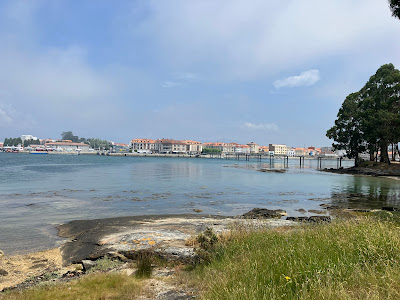If I seem little crazy today, it’s because the moon was shining on me last night through the open window. I spent a comfortable night at the Hotel Xeito (44€). There was a little misunderstanding (literally) but nothing too serious.
In the morning I observed an amazing scene. It was low tide, and on the sand and in the shallow water of the bay there must’ve been a hundred people or more searching for some kind of shellfish as they must have been doing since historic times. I took a last look at the fishermen’s village. Many of these houses were built as early as the 17th C. Notice the horreos in which they would have protected their vegetables and grain from the rats. With their fish and their vegetables and their grain, these seafaring villagers must have been self sufficient.
Speaking of horreos, I forgot to tell you yesterday about the other feature of the monastery at Poio. In the yard was the largest horreo in the world. It must have been 50 yards long.
I left the water and began to climb, a bugger of a climb, up the road, with very steep sections, fortunately followed sometimes by a levelling off.
About a quarter of the way up the climb was one of those little hospitality stands typical of the Camino. It was unattended, and relied for payment for drinks from the fridge on the goodwill of the pilgrims, quite different from the stands I had passed earlier along the Portugués, those little commercial enterprises selling, trinkets or offering to stamp your credential. Free Stamp said the sign, but you were expected to buy something or leave a donation. This morning was quite different. Someone was thinking about the pilgrims and not their own pocket. This variant is very much the Camino as it used to be.
Across the road was an old lady climbing some stairs, taking as long as it would take me to climb this hill. Old age cometh to us all.
The road steepened and wound up into the hills. Fortunately, it was a glorious day. This climb would be misery beyond measure in the rain. I was almost enjoying it! The road continued through a forest of gum trees, with bracken, yellow daisies, and fox gloves along the banks, and, of course, the little shrubby broad-leafed gum trees which hadn’t yet reached puberty. They grow like weeds.
Sorry to harp on about the gum trees, but they fascinate me. At first I thought they couldn’t have been planted because they were so close together, but this morning I noticed groups of young trees planted in rows. Perhaps further saplings then spring up between the rows. They really do grow like weeds.
I passed the municipal dog pound, and the silence was shattered. Dogs were running around in all directions. I saw my little dog Jala in there.
I wasn’t alone on the road this morning. A young fellow with a day pack raced by me at the speed of sound. I chatted with a young girl who had set out early this morning from Pontevedra. Another woman hurried by with 30 kms to go. No time to stop, she said. I conversed with a couple from the other side of Spain. “Viva Catalonia” were the only words I understood. A couple of horses came out from the woods to munch the grass at the side of the road. Their young goal followed, but seeing me, skittered away.
At last I reached a plateau and began a slight descent. This was obviously logging country with plantations of eucalypts vying for supremacy with for plantations of pine. Huge piles of debris on the side of the road may have been waiting until it was safe to burn. Bracken and even the shrubby gum trees were taking over the scarred landscape left by the logging.
And then I made sudden turn off the road, down a narrow path, and arrived at Armenteira. After a welcome coffee bar at the bar, too early for a beer, I paid a quick visit to the monastery, this time a convent. Nine nuns remained in this massive building. Yesterday at Poio, there were nine monks. Free entry but not many parts were open. I wandered around the cloister. Beautiful things, cloisters. The monks or nuns may have been cloistered within, but at times they were free to walk around the cloister and chat.
It was one o’clock, so I decided to bypass the albergue and head for the next accommodation seven kms on. And then I began the Ruta de la piedra y del agua or should I say Ruta da Pedra e da auga in Galicia, the route of stone and water, so aptly named, for it included stony scrambles, stone steps, stone walls, and stone mills, all the while the water rushing alongside. Some of these mills were primitive sawmills: others would grind wheat to make flour. I must have walked downhill for a couple of hours along this idyllic way, a scramble at times, but eventually levelling out to a gentle path. For me, this was one of the most beautiful stretches of any Camino.
Eventually, I arrived at Hospedaje Rustico Os Castaños. Bed and breakfast for 35€. It was quite a glorious day!
















